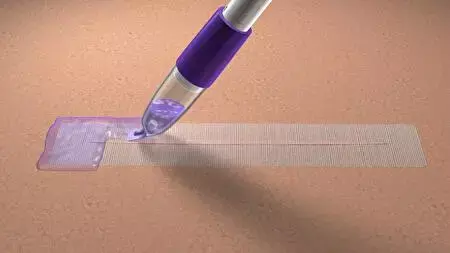- Home
- Medical news & Guidelines
- Anesthesiology
- Cardiology and CTVS
- Critical Care
- Dentistry
- Dermatology
- Diabetes and Endocrinology
- ENT
- Gastroenterology
- Medicine
- Nephrology
- Neurology
- Obstretics-Gynaecology
- Oncology
- Ophthalmology
- Orthopaedics
- Pediatrics-Neonatology
- Psychiatry
- Pulmonology
- Radiology
- Surgery
- Urology
- Laboratory Medicine
- Diet
- Nursing
- Paramedical
- Physiotherapy
- Health news
- Fact Check
- Bone Health Fact Check
- Brain Health Fact Check
- Cancer Related Fact Check
- Child Care Fact Check
- Dental and oral health fact check
- Diabetes and metabolic health fact check
- Diet and Nutrition Fact Check
- Eye and ENT Care Fact Check
- Fitness fact check
- Gut health fact check
- Heart health fact check
- Kidney health fact check
- Medical education fact check
- Men's health fact check
- Respiratory fact check
- Skin and hair care fact check
- Vaccine and Immunization fact check
- Women's health fact check
- AYUSH
- State News
- Andaman and Nicobar Islands
- Andhra Pradesh
- Arunachal Pradesh
- Assam
- Bihar
- Chandigarh
- Chattisgarh
- Dadra and Nagar Haveli
- Daman and Diu
- Delhi
- Goa
- Gujarat
- Haryana
- Himachal Pradesh
- Jammu & Kashmir
- Jharkhand
- Karnataka
- Kerala
- Ladakh
- Lakshadweep
- Madhya Pradesh
- Maharashtra
- Manipur
- Meghalaya
- Mizoram
- Nagaland
- Odisha
- Puducherry
- Punjab
- Rajasthan
- Sikkim
- Tamil Nadu
- Telangana
- Tripura
- Uttar Pradesh
- Uttrakhand
- West Bengal
- Medical Education
- Industry
Adhesive 2-octyl safe and effective wound closure technique for patients undergoing TKA: study

Good wound healing is critical to infection prophylaxis and satisfactory rehabilitation in Total Knee Arthroplasty (TKA). Currently, two techniques, i.e., barbed continuous subcuticular suture without skin adhesive or combined use skin adhesive (n-butyl-2) are being used for superficial wound closure of TKA. While a new skin adhesive (2-octyl) with self-adhesive mesh has been employed as an alternative to conventional surgical skin closure in TKA, its superiority, especially in reducing wound complications and improving wound cosmetic outcomes has not been investigated.
Liu et al conducted a study to compare 2-octyl, n-butyl-2, and no skin adhesive in terms of safety and efficacy in TKA superficial wound closure. It has been published in ‘Arthroplasty’ journal.
The authors conducted a multicenter, prospective, randomized controlled study in 105 patients undergoing primary TKA. Each patient’s knee was randomized to receive 2-octyl, n-butyl-2, or no skin adhesive skin closure with all using barbed continuous sutures in deep tissue. Wounds were followed 1, 3, 5 days, 2, 6 weeks, and 3 months after surgery. Wound discharge, complications, cosmetic outcomes, patient satisfaction, and wound-related costs were compared among these three methods.
Key findings of the study were:
• Wound discharge was less in 2-octyl group and n-butyl-2 group than in non-adhesive group at 1 day, with the discharge only being less in 2-octyl group than in the non-adhesive group at day 3 and day 5 days (P<0.05).
• There was no statistical difference in the incidence of other wound complications among the groups (P>0.05).
• The 2-octyl group achieved better cosmetic efects than the other two groups in 6 weeks and 3 months (P<0.05).
• Compared to the non-adhesive group, 2-octyl group scored higher in overall patient satisfaction score in 2 weeks and incurred lower costs (P<0.05).
The authors concluded that – “Skin closure in TKA using 2-octyl adhesive material showed superiority to no skin adhesive or n-butyl-2. It reduced wound discharge and improved cosmetic outcomes, without increasing wound complications. In addition, the use of 2-octyl could achieve excellent patient satisfaction and lowered costs compared to no skin adhesive. Our study demonstrated that the use of 2-octyl was a safe and effective as a wound closure technique in patients undergoing TKA.”
2-octyl: 2 -Octyl cyanoacrylate skin adhesive with flexible self-adhesive polyether mesh (DERMABOND PRINEO Ethicon, Inc)
n-butyl-2: N-butyl-2-cyanoacrylate skin adhesive (HISTOACRYL® B.Braun, Melsungen, German)
Further reading:
Comparison of the safety and efficacy of three superficial skin closure methods for multi-layer wound closure in total knee arthroplasty: a multicenter, prospective, randomized controlled trial. Liu et al Arthroplasty (2024) 6:51 https://doi.org/10.1186/s42836-024-00271-1
MBBS, Dip. Ortho, DNB ortho, MNAMS
Dr Supreeth D R (MBBS, Dip. Ortho, DNB ortho, MNAMS) is a practicing orthopedician with interest in medical research and publishing articles. He completed MBBS from mysore medical college, dip ortho from Trivandrum medical college and sec. DNB from Manipal Hospital, Bengaluru. He has expirence of 7years in the field of orthopedics. He has presented scientific papers & posters in various state, national and international conferences. His interest in writing articles lead the way to join medical dialogues. He can be contacted at editorial@medicaldialogues.in.


